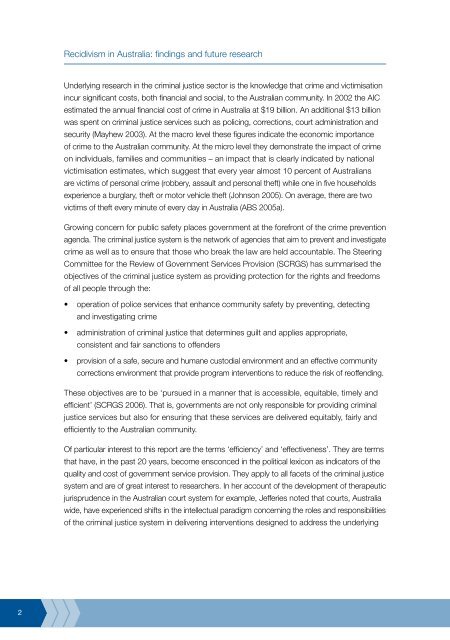Recidivism in Australia : findings and future research - Australian ...
Recidivism in Australia : findings and future research - Australian ...
Recidivism in Australia : findings and future research - Australian ...
Create successful ePaper yourself
Turn your PDF publications into a flip-book with our unique Google optimized e-Paper software.
2<br />
<strong>Recidivism</strong> <strong>in</strong> <strong>Australia</strong>: f<strong>in</strong>d<strong>in</strong>gs <strong>and</strong> <strong>future</strong> <strong>research</strong><br />
Underly<strong>in</strong>g <strong>research</strong> <strong>in</strong> the crim<strong>in</strong>al justice sector is the knowledge that crime <strong>and</strong> victimisation<br />
<strong>in</strong>cur significant costs, both f<strong>in</strong>ancial <strong>and</strong> social, to the <strong>Australia</strong>n community. In 2002 the AIC<br />
estimated the annual f<strong>in</strong>ancial cost of crime <strong>in</strong> <strong>Australia</strong> at $19 billion. An additional $13 billion<br />
was spent on crim<strong>in</strong>al justice services such as polic<strong>in</strong>g, corrections, court adm<strong>in</strong>istration <strong>and</strong><br />
security (Mayhew 2003). At the macro level these figures <strong>in</strong>dicate the economic importance<br />
of crime to the <strong>Australia</strong>n community. At the micro level they demonstrate the impact of crime<br />
on <strong>in</strong>dividuals, families <strong>and</strong> communities – an impact that is clearly <strong>in</strong>dicated by national<br />
victimisation estimates, which suggest that every year almost 10 percent of <strong>Australia</strong>ns<br />
are victims of personal crime (robbery, assault <strong>and</strong> personal theft) while one <strong>in</strong> five households<br />
experience a burglary, theft or motor vehicle theft (Johnson 2005). On average, there are two<br />
victims of theft every m<strong>in</strong>ute of every day <strong>in</strong> <strong>Australia</strong> (ABS 2005a).<br />
Grow<strong>in</strong>g concern for public safety places government at the forefront of the crime prevention<br />
agenda. The crim<strong>in</strong>al justice system is the network of agencies that aim to prevent <strong>and</strong> <strong>in</strong>vestigate<br />
crime as well as to ensure that those who break the law are held accountable. The Steer<strong>in</strong>g<br />
Committee for the Review of Government Services Provision (SCRGS) has summarised the<br />
objectives of the crim<strong>in</strong>al justice system as provid<strong>in</strong>g protection for the rights <strong>and</strong> freedoms<br />
of all people through the:<br />
•<br />
•<br />
•<br />
operation of police services that enhance community safety by prevent<strong>in</strong>g, detect<strong>in</strong>g<br />
<strong>and</strong> <strong>in</strong>vestigat<strong>in</strong>g crime<br />
adm<strong>in</strong>istration of crim<strong>in</strong>al justice that determ<strong>in</strong>es guilt <strong>and</strong> applies appropriate,<br />
consistent <strong>and</strong> fair sanctions to offenders<br />
provision of a safe, secure <strong>and</strong> humane custodial environment <strong>and</strong> an effective community<br />
corrections environment that provide program <strong>in</strong>terventions to reduce the risk of reoffend<strong>in</strong>g.<br />
These objectives are to be ‘pursued <strong>in</strong> a manner that is accessible, equitable, timely <strong>and</strong><br />
efficient’ (SCRGS 2006). That is, governments are not only responsible for provid<strong>in</strong>g crim<strong>in</strong>al<br />
justice services but also for ensur<strong>in</strong>g that these services are delivered equitably, fairly <strong>and</strong><br />
efficiently to the <strong>Australia</strong>n community.<br />
Of particular <strong>in</strong>terest to this report are the terms ‘efficiency’ <strong>and</strong> ‘effectiveness’. They are terms<br />
that have, <strong>in</strong> the past 20 years, become ensconced <strong>in</strong> the political lexicon as <strong>in</strong>dicators of the<br />
quality <strong>and</strong> cost of government service provision. They apply to all facets of the crim<strong>in</strong>al justice<br />
system <strong>and</strong> are of great <strong>in</strong>terest to <strong>research</strong>ers. In her account of the development of therapeutic<br />
jurisprudence <strong>in</strong> the <strong>Australia</strong>n court system for example, Jefferies noted that courts, <strong>Australia</strong><br />
wide, have experienced shifts <strong>in</strong> the <strong>in</strong>tellectual paradigm concern<strong>in</strong>g the roles <strong>and</strong> responsibilities<br />
of the crim<strong>in</strong>al justice system <strong>in</strong> deliver<strong>in</strong>g <strong>in</strong>terventions designed to address the underly<strong>in</strong>g















